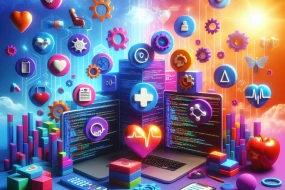
In the fast-paced world of software engineering, where hours can slip by unnoticed in the glow of multiple monitors, taking a stand—quite literally—can make a world of difference. Standing desks have surged in popularity, especially among tech professionals, promising not only improved health but also enhanced productivity. But what are the real benefits behind this trend, and how can software engineers make the most of their standing desks without falling into common pitfalls? Let’s delve into the health perspective of standing desks and uncover why they might be the best investment for your career and well-being.
The Sedentary Lifestyle of Software Engineers
Software engineers often find themselves glued to their seats for extended periods, immersed in code and problem-solving. This sedentary lifestyle is not just a cliché; it's a reality with significant health implications. Studies have linked prolonged sitting to increased risks of obesity, cardiovascular disease, and even certain types of cancer. For engineers, who might spend upwards of 8-10 hours a day sitting, these risks are magnified. The human body simply wasn't designed to sit for such long stretches, and the consequences can be severe.
Standing Desks: A Game Changer for Health
Standing desks have emerged as a powerful alternative to traditional seating arrangements, offering a dynamic way to combat the adverse effects of prolonged sitting. By allowing users to alternate between sitting and standing, these desks promote movement and circulation, reducing the risk of developing chronic conditions associated with inactivity. The simple act of standing can burn more calories than sitting, which can be a crucial factor in maintaining a healthy weight. Moreover, standing desks can improve posture and alleviate back pain—a common complaint among those who spend long hours at a desk.
Boosting Productivity and Focus
Beyond health benefits, standing desks can also enhance productivity and focus, which is essential in the high-stakes world of software development. When standing, individuals often report feeling more alert and engaged. This could be due to increased blood flow and oxygen to the brain, which standing promotes. Anecdotal evidence from tech giants like Google and Facebook, where standing desks are commonplace, supports this notion. Engineers who use standing desks often find themselves more focused and less prone to the afternoon slump that can derail productivity.
Making the Transition: Tips for Software Engineers
Switching to a standing desk is not without its challenges. Here are some practical tips for making a smooth transition:
1) Start slow: Begin by standing for 15-30 minutes at a time and gradually increase your standing time.
2) Invest in a quality mat: Anti-fatigue mats can make standing more comfortable by reducing strain on your feet and legs.
3) Adjust your monitor: Ensure your screen is at eye level to prevent neck strain.
4) Wear comfortable shoes: Supportive footwear can make a big difference in comfort.
5) Listen to your body: If you experience discomfort, don't hesitate to sit down and rest.
Common Mistakes to Avoid
While standing desks offer numerous benefits, there are common mistakes that can negate their advantages:
1) Standing too much: Just as sitting too much is harmful, so is standing for prolonged periods. Balance is key.
2) Poor posture: Slouching or leaning can lead to back and neck pain. Maintain an upright posture.
3) Neglecting ergonomics: Ensure your desk setup is ergonomic to avoid strain.
4) Ignoring discomfort: Pain is a signal that something is wrong. Adjust your setup if discomfort persists.
5) Lack of movement: Standing desks should encourage movement, so remember to shift positions and take breaks.
The Long-term Benefits
The long-term benefits of using a standing desk can be profound. Regular use can contribute to improved cardiovascular health, reduced risk of metabolic syndrome, and better mental health outcomes. Software engineers who make use of standing desks often report feeling more energetic and less fatigued, which can contribute to a more sustainable work-life balance. Over time, the cumulative health benefits can lead to a longer, healthier career in the tech industry.
Conclusion: Standing Desks as a Smart Investment
In conclusion, standing desks represent a smart investment for software engineers seeking to enhance their health and productivity. While the transition requires some adjustment, the long-term benefits far outweigh the initial challenges. By integrating standing desks into their work routines, engineers can take proactive steps to safeguard their health and well-being while keeping their minds sharp and focused. In a field where innovation is key, standing desks offer a simple yet effective way to innovate one's approach to work and health.































